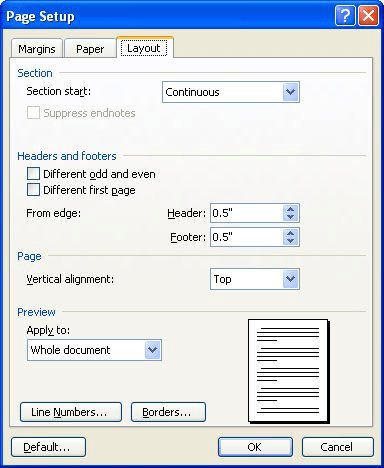Please Note: This article is written for users of the following Microsoft Word versions: 97, 2000, 2002, and 2003. If you are using a later version (Word 2007 or later), this tip may not work for you. For a version of this tip written specifically for later versions of Word, click here: Adjusting Bottoms of Pages.
Written by Allen Wyatt (last updated August 14, 2021)
This tip applies to Word 97, 2000, 2002, and 2003
When presenting some types of writing, it is very helpful that the last line of each page end at the same vertical position as the other ending lines on other pages. For instance, when working with poetry it is common for the last lines of each page to line up vertically.
If you want to align information vertically in this manner, follow these steps:

Figure 1. The Layout tab of the Page Setup dialog box.
Now the paragraphs on a page are adjusted vertically so they are evenly spaced between the top and bottom margin. This is helpful for poetry, where most paragraphs consist of a single line. It is a bit less helpful for other types of writing, since the Vertical Alignment specification doesn't affect spacing inside a paragraph (between lines), only the spacing between paragraphs.
If your writing requires different length paragraphs, and you want increased spacing between actual lines, you will need to experiment with line spacing to get a "look" that matches your needs. Once you settle on the appropriate line spacing, you can define a style that can then be applied to all your paragraphs. When combined with the Vertical Alignment setting already discussed, you may achieve the desired appearance.
Also, you may not like the appearance of your writing when you are using a large page size and your text consists of only a few lines. With justified vertical alignment set, this results in huge white areas between paragraphs. There are only two ways around this: You must either increase the amount of text on the page or decrease the page length.
WordTips is your source for cost-effective Microsoft Word training. (Microsoft Word is the most popular word processing software in the world.) This tip (633) applies to Microsoft Word 97, 2000, 2002, and 2003. You can find a version of this tip for the ribbon interface of Word (Word 2007 and later) here: Adjusting Bottoms of Pages.

Create Custom Apps with VBA! Discover how to extend the capabilities of Office 365 applications with VBA programming. Written in clear terms and understandable language, the book includes systematic tutorials and contains both intermediate and advanced content for experienced VB developers. Designed to be comprehensive, the book addresses not just one Office application, but the entire Office suite. Check out Mastering VBA for Microsoft Office 365 today!
Most everyone knows that Word allows you to set top, bottom, left, and right margins for your document. There is another ...
Discover MoreWhen you divide your document into sections in order to change page layout attributes, you need to give some thought to ...
Discover MorePart of determining page layout is to specify the size of the margins that surround the text on a page. Word allows you ...
Discover MoreFREE SERVICE: Get tips like this every week in WordTips, a free productivity newsletter. Enter your address and click "Subscribe."
There are currently no comments for this tip. (Be the first to leave your comment—just use the simple form above!)
Got a version of Word that uses the menu interface (Word 97, Word 2000, Word 2002, or Word 2003)? This site is for you! If you use a later version of Word, visit our WordTips site focusing on the ribbon interface.
Visit the WordTips channel on YouTube
FREE SERVICE: Get tips like this every week in WordTips, a free productivity newsletter. Enter your address and click "Subscribe."
Copyright © 2025 Sharon Parq Associates, Inc.
Comments